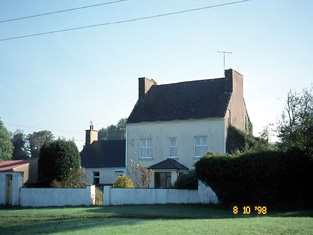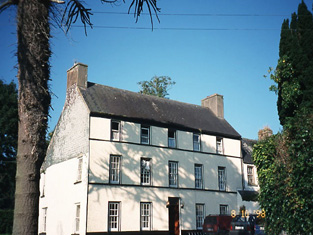Knockaneacoolteen House
Houses within 5km of this house
Displaying 9 houses.
Houses within 5km of Knockaneacoolteen House
Displaying 9 houses.
| House name | Description | |
|---|---|---|
| Molahiffe House | Eliza Griffin was the lessor of this property at the time of Griffith's Valuation, when it was valued at almost £6 and vacant. In 1837 Lewis mentions "Boucheens" as the residence of Montague Griffin. Bary states that this is a very old house and is widely believed to be one of the earliest homes of the Browne family, later Lords Kenmare. It is still extant and occupied. |

|
| Cloonlara | Christopher Gallway was leasing this property to William Hickson at the time of Griffith's Valuation, when it was valued at £7 5s. A farm is still extant at the site. | |
| Corbally House (Magunihy) | The Kenmare estate was the lessor of Corbally House at the time of Griffith's Valuation, when it was valued at £11 5s. Bary states that this farm was originally held by the O'Connor, probably of nearby Fieries Castle. Later a Fr. Dunne built Corbally House as a presbytery near the old Catholic Church. The property is still extant and occupied. | |
| Inchinveema | Christopher Gallway was leasing this property to Daniel Sullivan at the time of Griffith's Valuation, when it was valued at £6. Buildings are still extant at the site. | |
| Riverville (Currans) | Charles Blennerhassett held this property in fee at the time of Griffith's Valuation, when it was valued at £9 15s. Lewis records Riverville as the seat of Richard Marshall in 1837. The Ordnance Survey Field Name Books record Riverville as the residence of Richard Marshall c.1840, describing it as "a thatched house of oblong shape". Bary states that the house was a seat of the Marshell family and believed to have been built by them in the eighteenth century. They remained there until the 1840s. Later in the nineteenth century it was associated with the Spring family It is still extant and occupied. | |
| Ash Hill House | The Ordnance Survey Name Books record Ash Hill House, parish of Ballymacelligott, as being a ruin, c.15ft high in the 1830s. It had been built by the Blennerhassetts around 1700 and was later occupied by the Eager family. In 1786 Wilson records Ash-Hill as the seat of Thomas Blennerhasset. | |
| Currans House | The Ordnance Survey Name Books record Currans House as in a "decayed condition" in 1840. It was allegedly built c.1700. Francis Peet had resided there until c.1829. At the time of Griffith's Valuation, it was in the possession of Charles Daly, unoccupied and valued at £3. It is labelled Currans House on both the 1st and 25-inch edition Ordnance Survey maps. A house is still extant at the site. | |
| Roxborough (Molahiffe) | Wilson, writing in 1786, refers to Roxborough as the seat of Francis Chute. At the time of Griffith's Valuation, the townland was part of the estate of Reverend George Chute and Roxborough House was occupied by a Mrs Kenny and valued at almost £7. It is still extant and used as a farmhouse. | |
| Molahiffe Castle | At the time of Griffith's Valuation, Maurice de Coursey was leasing a property in the townland of Castlefarm from the Kenmare estate which had a valuation of almost £6. It is likely to have been the house labelled on both the 1st and later 25-inch edition Ordnance Survey Maps as Molahiffe Castle. The National Inventory of Architectural Heritage states that this house was built in the mid-eighteenth century. In 1943 the Irish Tourist Association Survey highlights the close links between Molahiffe and the Browne family, who, it says, resided in the area until the building of the first Killarney House. The remains of the original Molahiffe castle are located a short distance from the present house, now known as Castlefarm House. |

|

